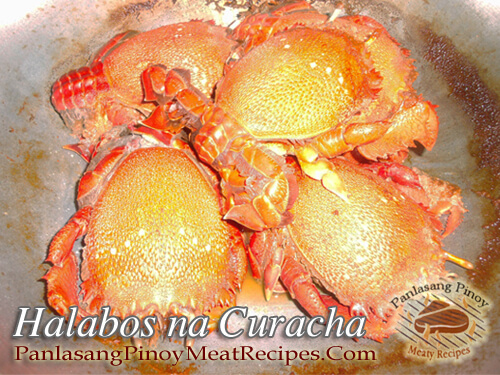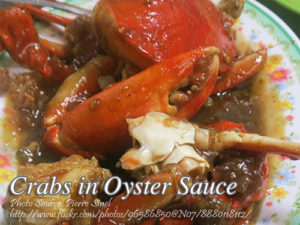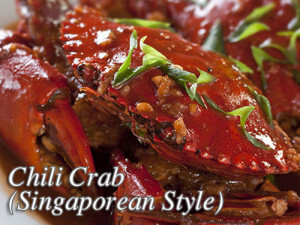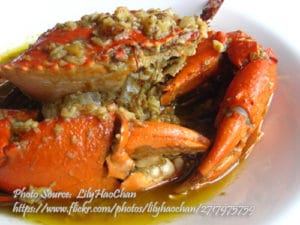The simplest way of cooking seafoods such as crabs, shrimps and of course the curacha is by halabos or hilabos which is cooking it by just a small amount of water with a little salt. You can taste the natural flavor of seafood by cooking it that way specially the curacha which is already tasty and full of flavor by itself without using a lot of seasonings. Actually we just in tried to cook this halabos na curacha because I can’t think of a quick recipe to cook this. There aren’t many recipes of curacha you can find so I think this is the best I could think of. I was planning to make a ginataang curacha with string beans and squash but my dear wife insisted to cook halabos.
If you ever wonder what is curacha, it is a Chavacano delicacy and found only in Zamboanga (within the Philippines of course). You will also find it strange looking because of the shape which resembles a lobster and crab that you will think it’s a crossbreed. It has also other name such as redfrog crab or spanner crab because it really looks like a red colored frog when you see it crawl. Another noticeable characteristic is the color reddish pink which looks like it is already cooked. But the color will become more intense when it’s cooked, the shells are bright red.
Halabos na Curacha: A Taste of Zamboanga’s Beloved Delicacy
I still remember the first time I laid eyes on a curacha—that peculiar sea creature that looks like a mix between a crab and a lobster. It was during a family trip to Zamboanga when my cousin, Tito Mario, brought home a basketful of these bright red crustaceans, freshly caught from the Sulu Sea. My first thought? They looked like they had already been cooked! But no, that’s just their natural color. And when I asked my aunt how she planned to cook them, she smiled and said, “The simplest way is always the best—halabos na curacha.”
What Makes Curacha Special?
For those who haven’t encountered it yet, curacha, also called the red frog crab or spanner crab, is a delicacy found primarily in Zamboanga. Unlike regular crabs, its meat is naturally sweet and packed with flavor, making it a prized catch for locals and seafood lovers. Unlike blue crabs that require a bit of effort to extract the meat, curacha’s flesh is more abundant and easier to enjoy, especially when cooked right.
In many Filipino households, when there’s fresh seafood, the go-to cooking method is halabos—a technique that involves steaming the seafood in a small amount of water with just salt. Some prefer to add soda, like Sprite or 7-Up, to bring out the natural sweetness. And this is exactly how we prepared our halabos na curacha that day in Zamboanga.
The Simplicity of Halabos na Curacha
Sometimes, the best dishes come from the simplest methods. My wife, Elisa, swears by this technique because it allows the natural flavors of the seafood to shine. Originally, I had planned on making ginataang curacha with string beans and squash, but she insisted that we keep it simple this time. “Trust me,” she said, “you don’t need anything fancy for curacha.”
The key to cooking halabos na curacha is freshness. Since the meat is already full of briny sweetness, minimal seasoning is required. Instead of overpowering the dish with spices, we only needed salt, a splash of Sprite, and a bit of butter to give it a silky finish.
Why This Cooking Method Works
The halabos method works beautifully for curacha because it gently steams the crab in its own juices while enhancing its natural flavors. The carbonation in the soda acts as a tenderizer, helping to break down the shells slightly so the flavors infuse better. The salt helps to bring out the oceanic taste, while the butter adds just a hint of richness that complements the sweetness of the meat.
Many people make the mistake of overcooking seafood, but the trick is to simmer just until the curacha turns an even more vibrant shade of red, and the juices release from the shell. This way, the meat remains tender and succulent.
How to Prepare Halabos na Curacha
Before cooking, it’s important to clean the curacha properly. My Lola used to say, “Ang paglilinis ng seafood ay parang pag-aalaga—dapat malinis at maingat.” (Cleaning seafood is like taking care of something—you must be thorough and gentle.) We always rinse the crabs under running water and use a toothbrush to scrub the shells, ensuring no sand or debris remains.
Once cleaned, the curacha goes straight into a pot, sprinkled with salt, and poured over with Sprite. We let it come to a boil, then lower the heat and let it simmer until almost all the liquid has evaporated. A generous knob of butter goes in at the last minute, giving the dish a smooth, glossy finish.
Serving and Enjoying This Zamboanga Delicacy
When the dish is ready, it’s best enjoyed immediately, while the shells are still warm and glistening. In our family, we serve halabos na curacha with steaming white rice, a side of toyomansi (soy sauce with calamansi), and a few slices of fresh tomatoes. Some like to pair it with vinegar for an added tang, but for me, the natural taste of the curacha is already perfect on its own.
Eating curacha is an experience—there’s a satisfying joy in cracking open the shell, pulling out the juicy meat, and savoring its sweet, briny goodness. Whenever I cook this dish, I’m instantly transported back to that warm afternoon in Zamboanga, sitting around the table with my family, hands messy but hearts full.
A Taste of Home and Heritage
Halabos na curacha is more than just a simple dish; it’s a taste of Zamboanga’s coastal heritage. It reminds us that sometimes, the best flavors come from keeping things simple and letting nature’s bounty shine. If you ever find yourself with a batch of curacha, try this method and experience how a few humble ingredients can create something truly delicious.
And just like my wife said, “You don’t need anything fancy for curacha.” She was right all along.
How to Cook Halabos na Curacha
Ingredients
- 1 kilo curacha redfrog crab or spanner crab
- 2 Tbsp. butter
- 1 Tbsp. sea salt or rock salt
- 1 cup sprite or 7-Up
Instructions
How to Cook Halabos na Curacha:
- Wash the curacha in running water and use toothbrush to clean the shells if necessary. Drain.
- Put the curacha in a cooking pot or medium size wok. Sprinkle with salt, pour the sprite or 7-up and butter.
- Bring to a boil than simmer until the curacha is cooked and almost all the liquid has evaporated.
- Transfer to a serving dish and serve.
Notes
Cooking Tips:
Clean the Curacha Thoroughly for Best Flavor
Before cooking, make sure to rinse the curacha under running water to remove any sand or debris. Using a toothbrush to scrub the shells ensures a cleaner, fresher taste without any unwanted grittiness. Proper cleaning enhances the natural sweetness of the crab and prevents any off-putting flavors.Use Soda to Enhance the Natural Sweetness
Adding Sprite or 7-Up instead of plain water infuses a slight sweetness that complements the briny taste of curacha. The carbonation also helps tenderize the shell, making it easier to extract the meat. This simple trick brings out the best flavors without needing extra seasonings.Avoid Overcooking to Keep the Meat Tender
Simmer the curacha just until it turns a deep, vibrant red and the liquid reduces slightly. Overcooking can make the meat tough and dry, losing its juicy and delicate texture. Keeping an eye on the cooking time ensures perfectly tender and flavorful crab every time.






Have you tried cooking them with Sprite, Salt, and spicy Filipino tomato sauce.?
And the curacha are not just found in zamboanga but also on the Pacific coast of Mindanao and even in butuan bay where I live (although not as many I think)
But where there are, they are delicious.!
Hi Shawn,
Thanks for visiting and sure I’ll try your recipe for cooking this curacha if I have a chance buying it here!